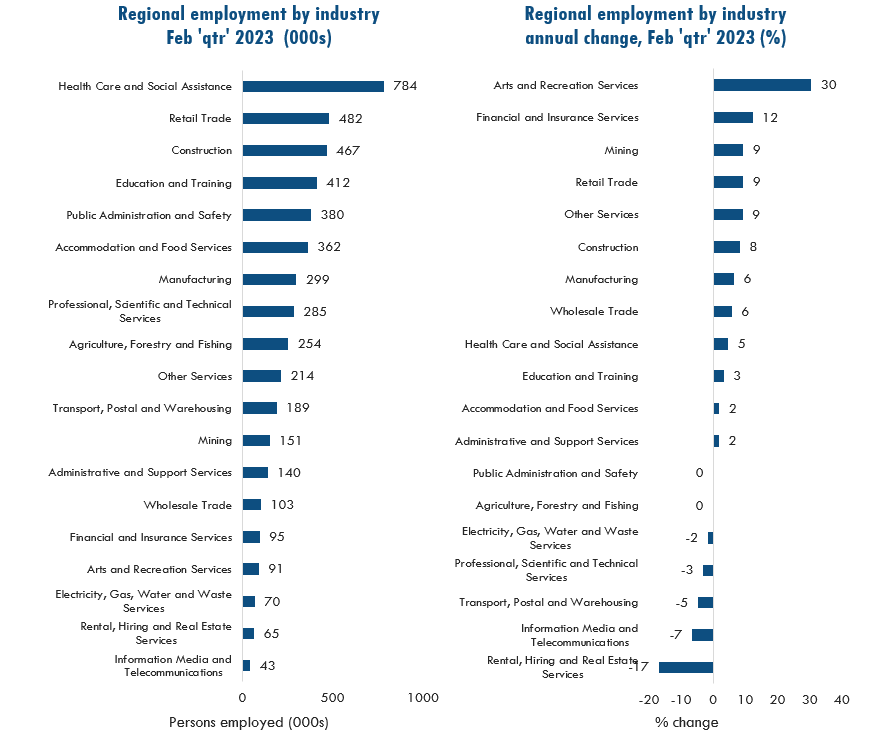Regional Labour Demand
Regional Australia continues to have an exceptionally tight labour market – with all headline indicators at, or near, record levels. This tight labour market is primarily a result of strong underlying economic conditions and high inbound migration from the major cities. However, the most recent data has provided a mixed picture of the labour market. Both employment growth and job vacancies are strong, with employers continuing to experience hiring difficulties in most industries. This indicates that many job seekers are easily finding work within our regions. At the same time, both the participation and unemployment rates experienced recent reversals (or at least pauses). The leads to an odd situation where the demand for workers is strong, the supply of job seekers is strong, but the number of people finding work is not growing as fast it should. Whilst we are seeing the ongoing effects of interest rate rises working their way through the economy, the most recent data hints at worsening alignment issues between employers and job seekers.
As explored in our Big Skills Gap Report, job vacancies are not evenly distributed, and in fact, highly concentrated. Just 10 occupation groups account for 40% of all job vacancies, with the top four accounting for a quarter of all regional job vacancies. The labour market data is painting a clear picture of skills misalignment. Data from the National Skills Commission indicates this is most prominent in trades-based occupations, as well as the care sector – such as child and aged carers.
Closing this misalignment gap is particularly challenging in regional Australia given the related gap in education availability and outcomes. The two reviews in 2017 and 2019 which underpinned the National Rural, Regional and Remote Education Strategy showed how underfunding of regional education (school and post school) is hampering the kinds of skills development regional Australians need to access the jobs on offer. Re-building regional learning systems will enable regional people to win the rewards of the higher skill jobs on offer, thereby raising average regional incomes. In parallel with renewed investment to enable regions to ‘grow their own’ skilled workforce, a revitalised national migration system is critical to bringing the right migrants (high, medium and low skilled) to the regional communities that are keen to welcome them.
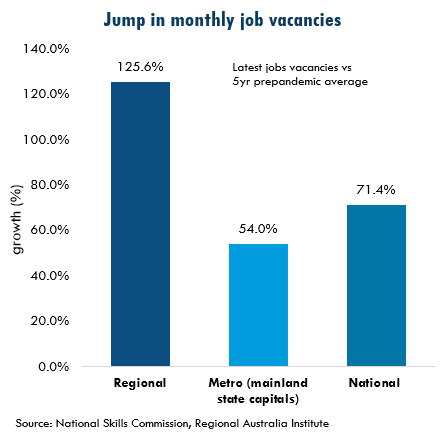
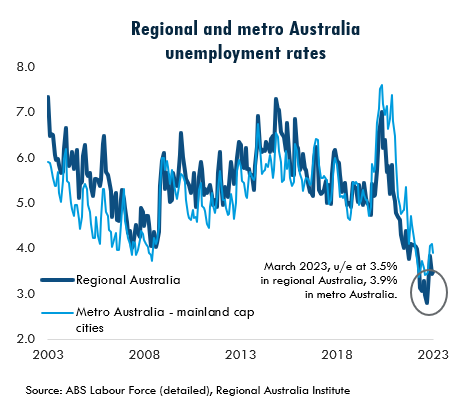
The regional labour force continues to grow
Regional Australia’s labour force reached 5 million people in late 2022 and continues to grow – currently sitting at 5,057,000. Over the last 12 months, an average of 14,000 people have joined the regional labour force every month (equating to an average annual growth rate of 3.1%). This is the highest ever growth in numbers, and one of the highest growth rates (in percentage terms) in Australia’s history.
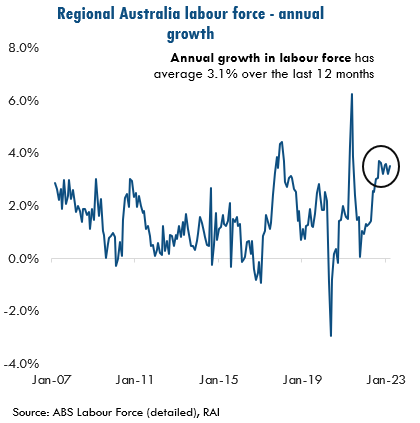
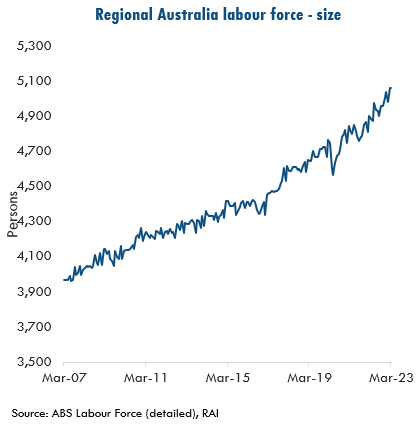
The participation rate pulled back slightly from its peak in the second half of 2022 and currently sits at 64.0% for March 2023 – and remains lower than the metro participation rate of 68.8%. This gap between metro and regional participation rates has been growing consistently for the past two decades, and currently sits at 4.9 percentage points, only slightly below the record high of 5.1 percentage points in early 2022.
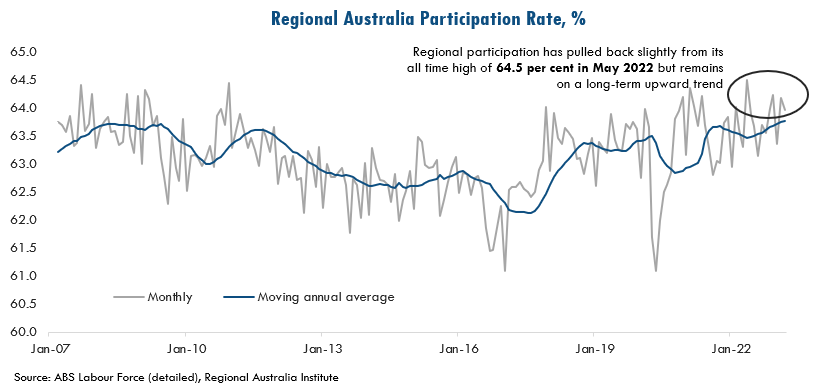
Unemployment
The unemployment rate saw a slight pause in its strong downward trend since July 2020, currently sitting at 3.5% for regional Australia - up from the record low of 2.8% in November last year. Given the surge in job vacancies for March 2023 and strong economic fundamentals, it is unlikely this increase for March 2023 represents a reversal of the two-year downward trend, but rather a pause. Recent increases in migration, as well as the ongoing effects of interest rate rises working their way through the economy, are possible causes. Regardless, there remains a record number of job vacancies for regional Australia, with employers still experiencing hiring difficulty and keen to attract talent.
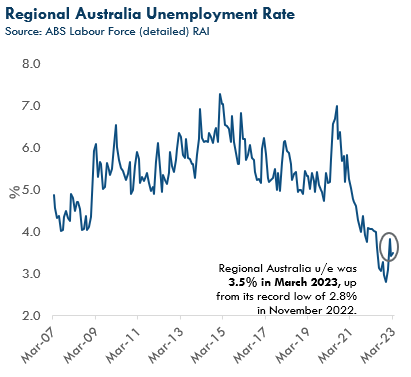
For the ninth consecutive months, the unemployment rate in Regional Australia has continued to outperform its metro counterpart – with a March 2023 figure of 3.5% compared to 3.9% for metro Australia.
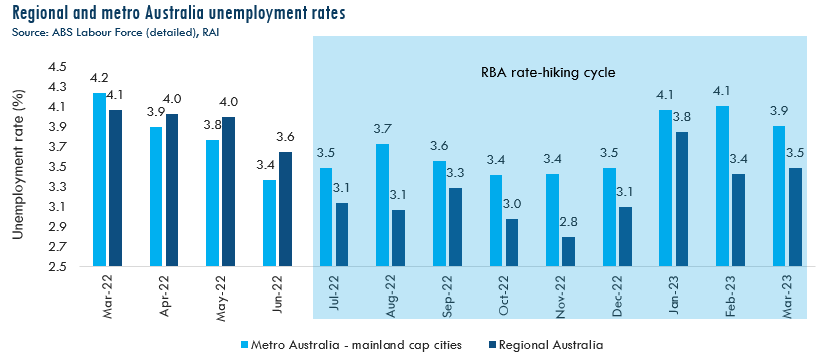
Regional Labour Demand
Regional job vacancies rebound to a high of 93,000
After hitting a low point during the three-month period from December 2022 to February 2023, regional Australia has witnessed a remarkable rebound in job vacancies. In March 2023, job vacancies surged to nearly 93,000 advertised jobs, marking a 15.2 per cent increase from February and a 10.1 per cent rise compared to a year earlier. The profile of annual growth in regional Australia contrasts with the situation in metro Australia, where job ads have declined by 2.1 per cent year-over-year.
Regional Australia job vacancies
Source: National Skills Commission, Regional Australia Institute
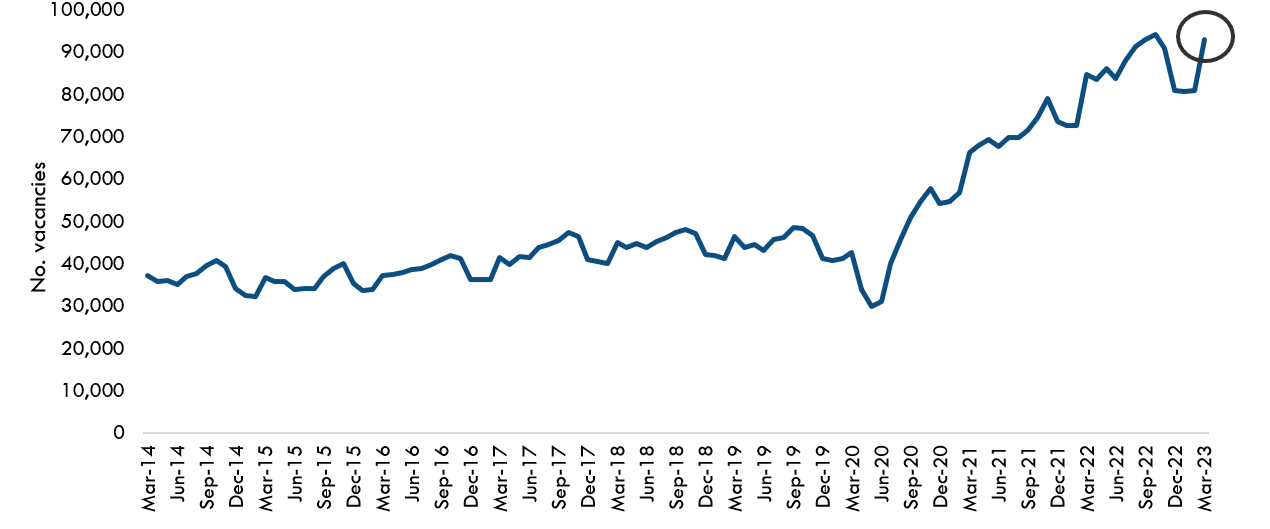
Tasmania, regional New South Wales, regional Queensland and the Northern Territory saw the largest increases in vacancies during the month. The top growth regions are scattered around New South Wales, Queensland and Tasmania. Latest advertised vacancies are well in excess of what was being advertised a month earlier in all regions. The monthly growth in vacancies in the various regions are in the double digits, with a concentration in the range of nearly 10 per cent to 20 per cent.
In comparison, the annual change in job ads exhibits a wider variation across all regions, ranging from a notable increase of 24.4 per cent to a modest decrease of 7.0 per cent.
The five regions that recorded the largest monthly increases in vacancies in March 2023 are
- Southern Highlands & Snowy in NSW with 19.4% more vacancies in March 2023 (1,360) than in February 2023 (1,139)
- Hobart & Southeast Tasmania up by 19.3% (2,229 compared to 1,869)
- Dubbo & Western NSW up by 18.1% (1,586 compared to 1,343)
- Central Queensland up by 17.2% (4,858 compared to 4,146)
- Newcastle & Hunter in NSW up by 16.8% (7,081 compared to 6,062)
The five regions with the largest annual increases in vacancies between March 2022 and March 2023 are:
- Tamworth and North West NSW up by 24.4%
- Blue Mountains, Bathurst & Central West NSW up by 22.7%
- Launceston and Northeast Tasmania up by 22.3%
- Toowoomba and South West QLD up by 21.8%
- Central Queensland up by 21.8%
In terms of the occupations being demanded, the most vacancies are for Professional roles (26% of all vacancies in March), followed by Technicians and Trades roles (16%), Community and Personal Service roles (13%), and Clerical and Administrative roles (13%).
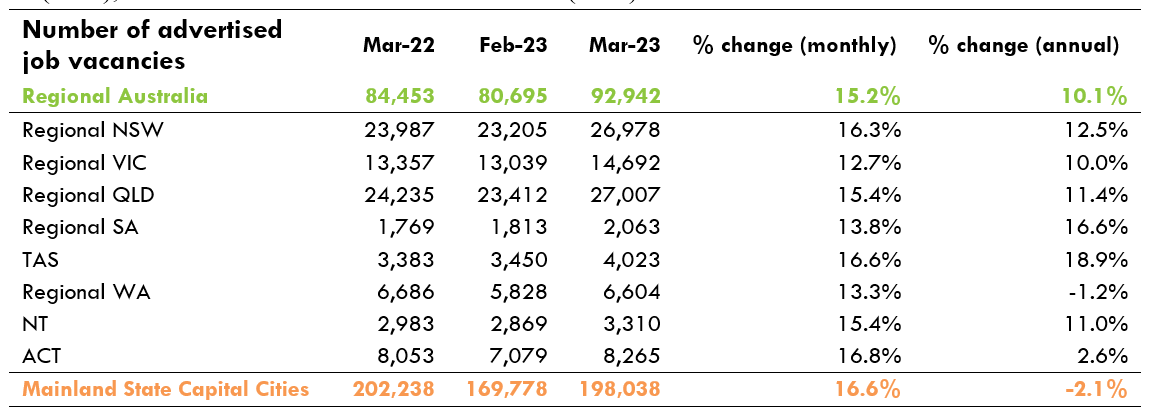
SOURCES The Internet Vacancy Index is updated monthly by the Department of Education Skills, Employment and Business (https://labourmarketinsights.gov.au/our-research/internet-vacancy-index/). The RAI has an interactive Regional Job Vacancy map of the data showing vacancies in 37 regions across Australia (regionalaustralia.org.au/home/regional-jobs-vacancy-map).
Additional regional labour market indicators:
Spread of unemployment rates across regions – lowest below 2 per cent, highest remaining above 10 per cent.
At the state level, employment growth for the quarter was mixed, with New South Wales (-1.0%), Western Australia (-0.7%) and Tasmania (-1.2%) seeing declines regional employment. However, the remaining states and territories experienced solid growth in regional employment levels, with South Australia (2.7%), Victoria (2.6%) and the ACT (2.6%) having the strongest employment growth for the quarter.
Although employment growth appears to have cooled off this quarter (temporarily at least), annual employment growth remains impressive – with all states and territories experiencing growth in regional employment. Victoria (6.0%), the ACT (5.7%), and regional New South Wales (5.4%) experienced the strongest annual growth.
A closer examination of the regions clearly shows the diversity amongst labour markets. Parts of New South Wales performed strongly in terms of lowering their unemployment rate, with New South Wales home to 3 of the top 5 regions with the largest improvements. The Barossa region was also a standout in terms of improved labour market conditions over the previous year.
Five key regions with the largest annual fall in unemployment rates
Source: ABS Labour Force (detailed), National Skills Commission, Regional Australia Institute

Regional Employment By Industry – Levels And Growth
Regional employment is close to reaching 5 million people - currently sitting at 4.9 million people as of February 2023 – 3.9% growth on last year. (This is not to be confused with the regional labour force mentioned previously, which includes persons engaged in employment, as well as those seeking employment). At the current growth rate, regional employment should reach 5 million people by Christmas, with most of the new jobs likely created in Health Care and Social Assistance; Retail Trade; Construction; and Education and Training.
Arts and Recreation Services saw a significant increase in employment with an additional 21,000 people compared to last year – representing a 31% increase. This brings the total industry size to a new record of 91,000 people employed in arts and recreation – which is great news for regional arts. Three other industries also reached record sizes this quarter – Financial and Insurance Services (95,000 people), Accommodation and Food Services (362,000 people) and Construction (467,000 people). The data now well supports the known regional construction and lifestyle boom.
